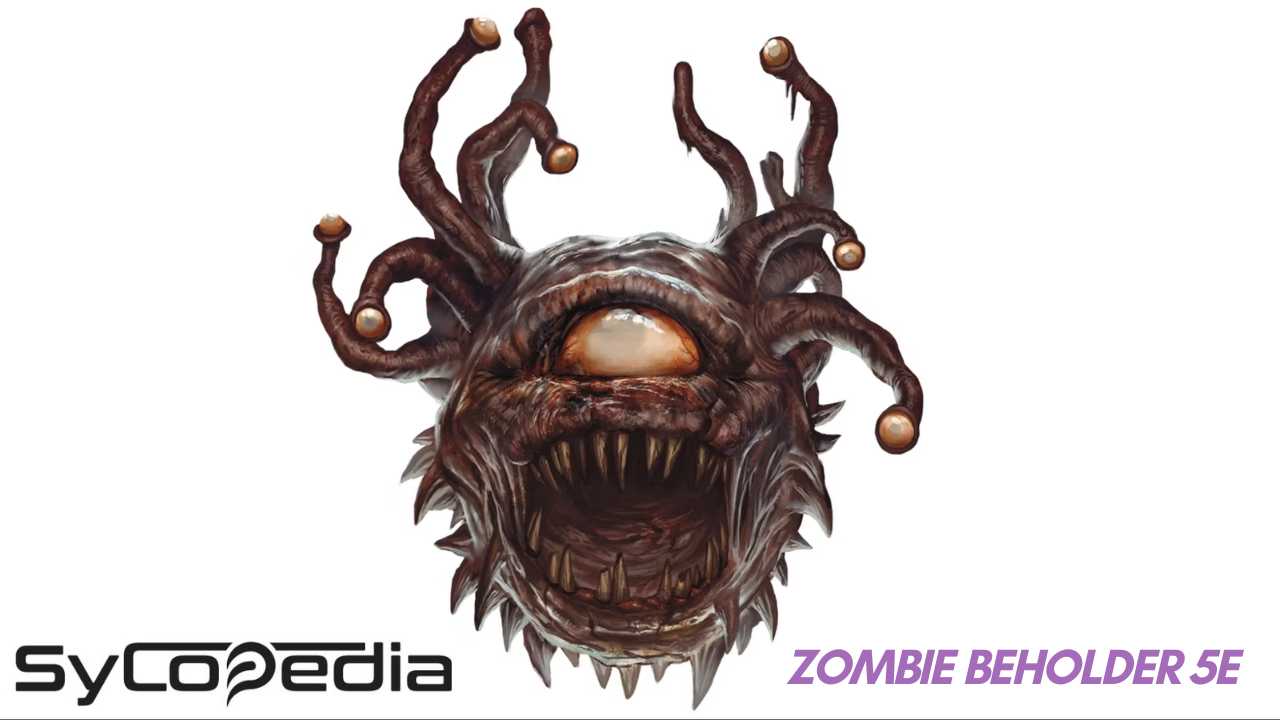The first time I faced the Beholder 5e, I thought, ‘Oh my god, this is too powerful and complicated.’ This creature has many eyes and deadly moves, so no matter how well you prepare yourselves, it will only take a few moments before even the most formidable characters transform into mere mortals.
Do you want to be prepared to take on a Beholder 5e when the time comes? Find out all the tactics, abilities, and characteristics you will need and some frequently asked questions. It’s time to shift this recognizable stiffness into an exciting win!
Overview of the Beholder in Beholder 5e
Originally appearing in Dungeons & Dragons 5th Edition, Beholder is a fabled monstrous threat known for its spells and the floating eye-lined sphere body.
These are all the more special because each of those eyestalks contains a unique magical ability and thus offers unpredictability in combat to the Beholder 5e.
Its central eye emits a cone of antimagic, which negates Magic in the area seen by the eye, which makes using Magic against it very difficult.
Spectators are also knowledgeable and tend to develop paranoid schizophrenia, and they trust themselves as superior beings in the multiverse.
Role in the Game
As for the gameplay, Beholders are usually utilized exclusively as outstanding antagonists. They usually schemed the big picture behind any story and occupied the giant lair with traps and minions.
Encountering a Beholder 5e is most frightful for any party of adventurers because the creature uses eye rays and has the power to neutralize any kind of Magic.
This is why meeting them has become such a fantastic experience filled with so much excitement.
Significance in beholder dnd 5e Lore
It will be clear that beholders have quite an understood or profound meaning in the Beholder dnd 5e lore context.
These are the original monsters that were present in the first editions of the game and are very much present in the Beholder dnd 5e universe.
They are characterized by specific physiology and highly developed societies living mainly in the Underdark or in other concealed areas.
Incorporation of villains in a campaign can also enhance the dimension and interest as most of them are associated with mystery and fete.
Beholder 5e Stats
As said, the beholder 5e stats are impressive and show sturdiness. The creature has a high armor class of 18 and can have several hit points, usually 180 (19d10+76).
Its maneuverability is that it can only move 0 ft on the ground while it can move 20 ft high per round. Beholder’s save bonuses are good, especially Dexterity, Constitution, and Wisdom ones, as well as his attack bonus… These make it challenging to get past its good defensive stats.
Understanding 5e beholder’s Powers
The 5e beholder’s powers stem from its various eye rays, each with unique magical effects, making it a formidable opponent:
- Charm Ray: Charms a target, turning them into a temporary ally.
- Sleep Ray: Puts the target into a deep sleep.
- Disintegration Ray: Disintegrates matter, potentially killing a creature outright.
- Death Ray: Deals massive damage, potentially killing the target instantly.
- Antimagic Cone: Neutralizes all magic within its field, disrupting spells and magical effects.
Stat Comparison with Other Creatures
In this regard, the Beholder 5e has abilities that are different from other creatures and good statistics.
| Creature | Hit Points | Damage Output | Special Abilities |
|---|---|---|---|
| Beholder | Medium | Medium | Antimagic cone, multiple eye rays, flight |
| Dragon | High | High | Breath weapon, flight, high damage resistance |
| Lich | Medium | High | Spellcasting, phylactery, undead resilience |
Strategies to Fight and Beat a Beholder 5e
Here are strategies to consider when preparing to fight and beat a Beholder 5e:
- Equipment Focus: Equip items that enhance resistance to magical attacks and improve saving throws.
- Protective Spells: Use spells like “Protection from Energy” to defend against the Beholder’s deadly eye rays.
- Ranged and Mobile Allies: Bring allies with high ranged attack capabilities and mobility to evade the Beholder’s gaze.
- Balanced Party Composition: Ensure a well-rounded party that includes healers, tanks, and damage dealers to handle various combat scenarios effectively.
Effective Combat Tactics
Here are the key tactics to use in combat against a Beholder:
- Tactic 1: Utilize cover to shield yourself from the Beholder’s eye rays.
- Tactic 2: Spread out to minimize the impact of area attacks and aim to disable the eye stalks.
- Tactic 3: Stay out of the range of its antimagic cone to keep spells and magical items functional.
- Tactic 4: Use spells that do not require line of sight, like “Summon Creatures” or “Cloudkill,” to damage the Beholder indirectly.
- Tactic 5: Maintain continuous pressure and string together attacks to keep the Beholder on the defensive.
Common Mistakes to Avoid
Here are some common mistakes to avoid when facing a Beholder:
- Avoid clustering together, as this allows the Beholder to target multiple party members with its eye rays.
- Do not rely solely on magic, as the Beholder’s antimagic cone can neutralize all magical abilities and effects.
- Always have a backup strategy for when magic is disabled to prevent a complete defeat.
- Underestimate the Beholder’s intelligence and strategic thinking at your peril; treat it as a cunning and tactical adversary.
Beholder 5e Tools
- Stat Blocks: All the possible specifics of the NPC, its skills, attributes, and behavior to enable the DMs to have better control of this monster when playing the game.
- Tactical Guides: Nowadays, finding ways for opponents to get creative and produce difficulty is a crucial type of tactic and advice for developing entertaining and difficult experiences that different gamers can’t experience with normal avatars or characters but are feasible only with a Beholder.
- Lore Resources: Pre-established history or stories about Beholders to contribute towards the setting and incorporate themselves easily into the campaign.
- Scenario Creation Tips: Concepts and templates for building scenes or a dungeon based on a Beholder, general traps and minions, and specific themes for the Beholder’s lair.
- Visual Aids: Miniatures and artwork digital models of Beholders used while playing the game at the table.
- Encounter Simulators: These programs help DMs model their interactions with Beholders. Depending on the players’ actions, the difficulty level and strategy can be changed.
Beholder Variants
There may also be some degree of difference; some variants will have more eye rays, different states, or some powers.
- Zombie Beholder: A lesser form of the standard Beholder, usually missing some eye stalks and possessing reduced abilities due to its undead nature.
- Death Tyrant: The undead form of a Beholder that retains all its malevolence and magical powers in death, gaining new necrotic abilities.
- Spectator: A summoned Beholder with only four eye stalks, tasked with guarding treasures or locations; it has fewer abilities and a lower threat level compared to a full Beholder.
Zombie Beholder 5e

The Zombie Beholder is a formidable undead variant of the standard Beholder, exhibiting unique characteristics:
- Retains a diluted form of the original Beholder’s eye ray powers.
- Maintains the fundamental features of a typical Beholder.
- Possesses a lower Armor Class (AC) and fewer hit points than its living counterpart.
- Immune to poison and cannot be put to sleep, silenced, or frightened.
- Although it still possesses eye rays, they are less frequent and not as potent as those of a standard Beholder.
Comparing Variants
Beholder’s Abilities and How They Work
A Beholder’s eye rays are its attacks, and everyone has a unique magical ability. Some of the key rays include: Others of the key rays are;
- Charm Ray: It can fascinate a creature and turn that creature into an ally of the target for some time.
- Paralyzing Ray: Assumes the role of temporarily paralyzing the target leaves the target stunned.
- Fear Ray: This makes the target run or, at least, be paralyzed with fear, which can be achieved by injecting the target with a paralyzing agent.
- Disintegration Ray: Erases matter that can, in a flash, kill a monster.
- Death Ray: It would yield high amounts of damage and could knock out the target on his first turn.
Antimagic Cone
In version 5e, the Beholder possesses one known as ‘Antimagic Cone‘, which removes magical effects as far as it can see.
This further elaborates that any magical spells or effects will be muted, and objects of Magic will be rendered inactive within the cone’s range.
Understanding this ability is important as it will allow a rogue to dispel magical protections and thus cause many problems for your party’s strategies if not for a mage’s defenses.
Conclusion
Facing a Beholder 5e is challenging while playing the game, and it is such an experience every gamer wants. Some of the issues that require takeaway from our conversation include the realization of the Beholder’s special abilities, such as eye rays and the antimagic cone, and the approach to the fight that is equipped with all the available tools, weapons, magic spells, and stances.
Over the past ten years, knowledge of the kinds available, such as the zombie beholder, has helped tell how each one will behave.
Overcoming Beholder 5e helps you deal with this powerful enemy and increases your enjoyment in Beholder dnd 5e. With your party, strategy, and understanding, proceed and enjoy your game until you feel ready to compete.
FAQs
How to Beat a Beholder 5e?
Gearing up had increasing saving throws and resistances in mind. It is advisable to use cover and spread out to avoid the effects of the eye rays. This creature has eye stalks and an antimagic cone, so keep your sights on its eye stalks. Non-LOS spells and teamwork must be employed.
How to Fight a Beholder 5e?
Stay away at range and stick to ranged combat. Disperse your party to lower the effect of the eye rays and employ spells that are immune to the antimagic cone. Please do not aim at the extended eye stalks, and do not stay still to reduce its chance of hitting you.
How to Kill a Beholder 5e?
Equip your party with protection against eye power and the anticipated field. It is advisable to utilize high-damage attacks, which will reduce the monster’s hit points. Synchronize the attack and use the ground wisely to avoid getting caught in the center of the eye.
Can a Beholder Understand Common 5e?
Yes, Beholders have the ability to both listen and speak the Common Language. Therefore, they can comprehend everything that the other characters are saying and can even plan their moves against them.


